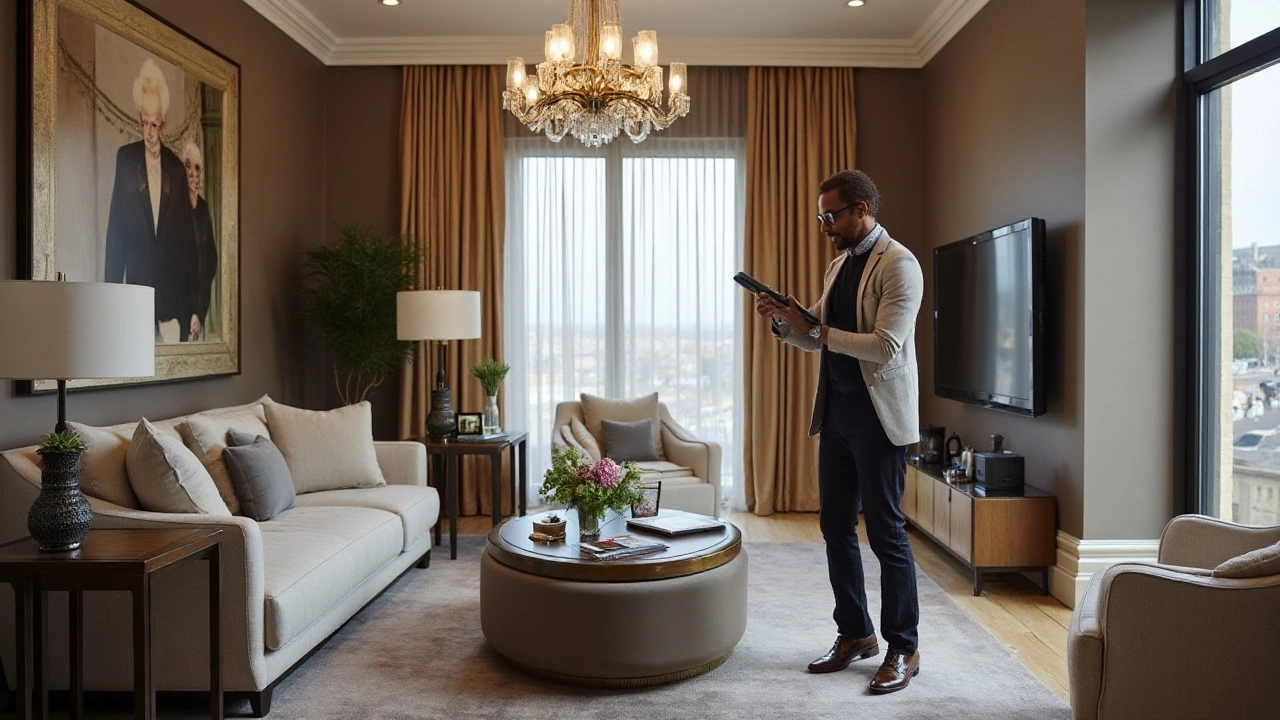Venturing into the world of interior design often sparks a vital question: how much can one expect to earn in this profession? It’s a query shrouded in a blend of curiosity and practicality, particularly for those contemplating this creative yet demanding career path. While interior design offers the allure of artistic freedom and impact, understanding the financial landscape is equally important.
Income for interior designers is as varied as the projects they work on. From transforming cozy one-bedroom apartments to masterminding the layouts of sprawling corporate spaces, the diversity in assignments can be as wide as the gap in salary expectations. Experience, specialization, and geographical location all play decisive roles in shaping an interior designer's paycheck.
Imagine a palette of financial outcomes, as extensive as the swatches of colors a designer might choose from. Knowing where one might fit on this spectrum is crucial. This exploration into designer earnings reveals both challenges and opportunities, offering insights that go beyond mere numbers.
- Factors Influencing Earnings
- The Income Range for Designers
- Comparing Salaries in Different Locations
- Tips for Increasing Your Salary
Factors Influencing Earnings
When it comes to determining how much an interior designer can earn, several factors come into play. It’s not just about possessing an eye for aesthetics; diverse elements contribute significantly to one's pay scale. At the forefront of these factors is experience. Those with several years in the field, particularly those who have built a robust portfolio, often command higher fees. Clients are more inclined to trust designers with proven track records, which translates into higher earnings for seasoned professionals. A newcomer may start with modest projects, gradually increasing in complexity and pay as their portfolio and reputation grow. Earning potential is inherently linked to how well a designer can communicate and deliver results that align perfectly with a client’s vision.
The geographical location where a designer works also plays a critical role in influencing their salary. Traditionally, urban environments with a higher cost of living, such as cities like New York, Los Angeles, or London, tend to offer higher salaries compared to smaller towns or rural areas. The logic is straightforward: clients in these bustling cities often demand high-end designs and are willing to pay a premium for expert services. Additionally, local markets' economic health can affect how much disposable income potential clients might have for home or business design projects. This regional variation means a designer's earning potential could pivot dramatically based on their choice of location.
Specialization within the interior design realm can substantially impact earnings as well. For instance, those who focus on niche markets such as sustainable design, historical restoration, or smart home technology often find themselves in high demand, which consequently boosts their earning power. These specialized fields require unique skill sets and knowledge bases that aren’t as widespread, making those who master them invaluable. A designer’s ability to carve out a unique niche can set them apart in a crowded market, often allowing them to charge premium prices. Many successful designers blend their passions with their professions, capitalizing on what makes their service offering distinct.
According to a survey by the American Society of Interior Designers, specialization in particular areas of design can dramatically increase income potential. In 2023, designers focused on sustainable practices reported a notable increase in project inquiries by over 20% compared to their generalist counterparts.Education and continuous learning are crucial influencers in a designer’s salary potential. Formal education provides a solid foundation, but staying updated with the latest design trends, technology, and techniques enhances a designer's expertise and desirability in the market. Participation in design workshops, certifications, and professional associations often reflect a commitment to the craft, which prospective clients and employers highly value. Engaging with the community and other professionals also opens doors to networking opportunities, providing more exposure and potential clients.
Lastly, the type of services offered and business model adopted can substantially affect a designer’s take-home pay. Designers who work for firms may enjoy stability and a steady income, albeit typically lower than what they might earn independently. Freelancers have the flexibility to set their rates and take on projects that align with their financial and creative goals, although this comes with the unpredictability and responsibility of running a business. Independent designers can increase their revenue streams by offering complementary services, such as project management or consultation, which can further diversify their income.

The Income Range for Designers
When exploring the interior designer salary, it is essential to recognize the spectrum of earnings that can be encountered in this field. At an entry-level position, a designer just starting out might expect a modest income, which might seem daunting at first. Typically, these early career designers might earn anywhere from $35,000 to $45,000 annually. This range is heavily influenced by the type of firm they join, the city they work in, and the demand for their stylistic expertise. With the multitude of pathways in interior design, some individuals choose to work for design firms while others venture into entrepreneurship, each avenue offering varied earning potentials.
As designers build their portfolios and gain experience, their earnings can take a positive turn. Mid-level interior designers, with several years of successful projects and perhaps specialization in a niche market such as sustainable design or commercial space optimization, can see their salaries increase significantly. In fact, these professionals might enjoy annual salaries in the range of $50,000 to $70,000. This uptick usually accompanies a period of professional growth where a designer's reputation begins to precede them, attracting higher-profile clients and more complex, rewarding projects.
For those reaching the upper echelons of the profession, the financial rewards can be substantial. Senior or principal designers, especially those who own firms or have carved out a reputation as an industry authority, might draw annual salaries upwards of $100,000. The pinnacle of success in this field, though, is reserved for celebrity designers whose earnings can exceed a quarter-million dollars, buoyed by exclusive contracts and high-stake projects. Consider designer Nate Berkus, who once noted,
"Success in interior design is not just about making a living; it's about earning the trust to transform lives through spaces."High earnings in such cases reflect not only their design acumen but also a career defined by exceptional client relationships and visionary creativity.
Breaking down the salary statistics can provide a clearer picture. According to data, the median annual wage for interior designers in the United States hovers around $57,000. However, this number conceals the large disparities driven by diverse working environments. Freelance designers are particularly noteworthy, as their income can vary widely based on their project's size and complexity, with some earning on par with their salaried peers while others exceed expectations through strategic client acquisitions and effective self-branding.

Comparing Salaries in Different Locations
The allure of an interior design career can be led partly by the potential to earn a rewarding salary, but where you practice often steers that financial expectation. Whether nestled in the bustling corners of New York or the tranquil outposts of rural towns, an interior designer’s earnings can vary as much as the styles they work to create. One might ask why these disparities exist, and how they significantly redefine the career paths for many in the design field.
In high-density metropolitan areas like New York City and Los Angeles, interior designer salary figures tend to top the charts. These urban hubs often give rise to higher living costs, which naturally push earnings upward. Designers in these cities might earn upwards of $70,000 to $100,000 annually, given the demand for sophisticated spaces and high-profile clients. These figures result from the vibrant art and culture scenes that strongly influence design trends and provoke more experimental projects.
By contrast, interior designers in smaller cities or rural areas might notice a leaner paycheck, more aligned between $40,000 and $60,000 annually. This gap is partly due to a smaller clientele base and a focus on residential rather than commercial projects. Yet, in these areas, designers often find their work-life balance enriched by lower living costs and a slower-paced environment. Interestingly, a staggered cost of living doesn’t always equate to diminished rewards. The satisfaction of really changing the personal atmosphere for clients in these regions can provide non-monetary rewards that thrive over mere numbers.
A designer contemplating a move or starting anew might wonder where best to set down roots. States like Texas have been known to find a sweet spot between bustling and balanced, offering competitive salaries of about $55,000 to $75,000 alongside a growing market for interior makeovers, fueled by economic booms in cities like Austin and Dallas. The opportunity here lies not just in designer earnings but in the chance to ride a wave of urban growth that welcomes contemporary and eclectic aesthetics.
"An interior designer's income can be as much about creativity as it is about location," notes a spokesperson from the American Society of Interior Designers. "It’s fascinating to consider how geographic trends can influence both the style and financial success of our members."
For those steadfastly focused on maximizing their financial success, considering international opportunities may hold the key. In countries like the United Arab Emirates, where an eye for opulence reigns supreme, designers frequently find lucrative contracts that dwarf domestic standards. Here, both experience and style command hefty paychecks, potentially reaching averages as high as $120,000 annually.
Understanding these landscapes helps demystify the role that location plays in an interior design career. The takeaway is not always straightforward—what suits one designer might not be ideal for another. Ultimately, it’s about aligning personal goals with the openings available in each distinct region. The result is a career that not only pays well but enriches the designer's life in other meaningful ways too.

Tips for Increasing Your Salary
Interior design is an ever-evolving field, brimming with opportunities for those who are ready to adapt and grow. If a lofty income is what you seek, it's crucial to not only hone your creative skills but also to employ strategic approaches to enhance your interior designer salary. Start with leveraging your network. Networking is not just about shaking hands at industry events; it's about building lasting professional relationships that can lead to lucrative referrals and collaborations. Make a point to attend design expos, join design associations, and actively participate in workshops. Each connection can be a stepping-stone toward higher-paying projects.
Beyond networking, diversifying your skill set can significantly boost your earning potential. Today’s interior designers are not just decorators; they play multifaceted roles including project management and sustainability consultancy. Consider deepening your expertise in areas like eco-friendly design, which is increasingly demanded. Certifications in sustainable design or proficiency in the latest design software can set you apart from the competition. Many firms value professionals who add a unique touch and can manage multiple aspects of a project, rewarding them accordingly.
Enhancing Your Skillset
One practical approach to enhance your skills is to embark on continuous learning. The design world is dynamic, with new trends and technologies constantly emerging. Engage in online courses or professional certifications that keep you abreast of the latest industry practices. Learning about high-tech tools and how to apply them effectively in your projects can make a substantial difference. Moreover, mastering advanced design software has become nearly indispensable. The ability to present your visions in a tangible format gives you a competitive edge when pitching to high-end clients and can lead to a higher designer earnings.
Further, aligning yourself with prestigious design agencies or brands can amplify your visibility and credibility. Such associations often come with steeper paychecks. But if you prefer to chart your own path as a freelancer, consider crafting a personal brand that highlights your unique style and voice. In the words of Coco Chanel, "In order to be irreplaceable, one must always be different." This mindset can help you captivate a niche market, enabling you to command premium pricing for your services.
Navigating the Freelance World
If freelancing is your route, it's vital to understand how to price your work competitively while ensuring you leave room for negotiation. Start by compiling a detailed portfolio that showcases a diverse range of completed projects. Potential clients are more likely to pay top dollar if they can see the caliber of your work. Setting flexible pricing structures based on project complexity and duration can cater to varied client needs while ensuring you don't undersell your talent.
"Success means doing the best we can with what we have. Success is the doing, not the getting; in the trying, not the triumph." - Zig Ziglar
Lastly, keeping abreast of the interior design income landscape through resources like industry publications can offer valuable insights. Some even adopt a proactive approach by consulting with financial advisors who specialize in creative professions to better understand how to maximize earnings and savings strategies tailored to their career. While the pursuit of a higher income in interior design requires concerted effort, these strategies can lead you onto a path of greater financial success and professional satisfaction.
